Louisa McGrath – 18 November 2015 - dublininquirer.com
The Battle Continues Over The Future Of Wolfe Tone Park
In recent months, the Wolfe Tone Park community has upped its campaign to have the cold, concrete space returned to its previous state: a pleasant, welcoming green oasis for the city.
And so far, the group – which is made up of residents of the Wolfe Tone Street/Jervis Street area – has had some success.
Of the 11 objectives it set out on its website, the group has achieved seven. These include removing commercial furniture and the council’s prefab staff toilets, as well as ending amplified music events in the park, which were a heart-scald for locals.
The last event to take place was Dublin Fringe Festival’s Spiegeltent in September. It featured a brass band, and at times noise levels reached 96.6 decibels inside some nearby apartments – similar to what you’d hear if you were standing near a jackhammer.
After Dublin City Council received a barrage of complaints from residents about the noise, Assistant Chief Executive Brendan Kenny appeased them. In an email, he assured locals that the Spiegeltent would not be permitted in the park by the council in future, and that no more daytime or night-time events would take place in the park.
That same month, the restoration of the park was included in the draft Dublin City Development Plan, which states that it is an objective of the council to implement a conservation plan for Wolfe Tone Park.
These two victories for the residents seemed like progress towards another one of their stated goals: to prevent any commercial operations in the park.
But little did they know that there would be no more room for circus tents or raucous events anyway, because plans to install a café were coming down the line.
The Council Plans a Café
At last Tuesday’s Central Area Committee meeting, the councillors present unanimously agreed to grant a three-year concession to The Tram Café.
If passed by councillors at next month’s city-wide meeting, the café will operate from a 1920s-style tram based in Wolfe Tone Park.
Some councillors, though, are already having second thoughts.
Fine Gael councillor Ray McAdam voted in favour of the café, and he is satisfied that the council will conserve the park and return it to its former, green glory, as promised.
“It would be fantastic to see it brought back to how it was in the late 1800s,” he said.
But now he seems less certain that the vote in favour of the tram café was a wise decision. He isn’t convinced there’s a need for a café there.
Independent councillor Mannix Flynn arrived to the Tuesday meeting late after he was informed of this proposal. Although he’s a councillor for another area of the city, he is determined that the park remain free from commercial activities.
Surely, Dublin can have one space that isn’t totally commercialised, he said, pointing out that the Church Bar adjoining the park has a café.
“I really think there’s a very strong case to restore the park to the way it was . . . It’s smack-bang in the middle of town, and it would be a fantastic place for it,” he said.
He is dismayed that councillors approved the proposal for the café, and that the parks department has put this forward before the conservation plan.
Conflicting Visions
The Wolfe Tone Park Community weren’t too happy with this development either, because it doesn’t fit in with what they had envisaged for the park.
“The tram café is a major concern for us here. We have thousands of options to buy a cup of tea . . . We are determined that Wolfe Tone Park is developed as a public amenity, free from commercial activity,” said Ciarán Flynn, a resident who has lived across from the park for more than 15 years.
Residents Park Design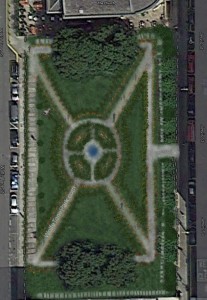
A vision for the park put together by some local residents.
The group’s ultimate goal was to have the park restored to the way it used to be, with grassy greens, walkways and the old fences, which the council still has in storage. Alternatively, the residents had agreed upon a design proposal for a traditional park layout with a simple water feature at the centre.
This would come in at a cost of €50,000, the same amount McAdam understands has been set aside by the council for the redesign in its 2016 budget.
“Once inside the gate, visitors could meander through the paths as they explore the perimeter headstones,” said Flynn. “This becomes a very different experience than the present prison-yard layout.”
A tram, he says, wouldn’t fit into either of these layouts.
Who’s Being Asked
Green Party councillor Ciarán Cuffe missed the vote at last week’s meeting, but later on he voiced his concerns over not being invited to the consultations that took place regarding the future of the park.
“I consider myself a stakeholder for Wolfe Tone Park . . . and I think our opinions are of value in this process. I’m a bit worried about being sidelined,” he said. McAdam also voiced concerns about the consultation process.
Instead, councillors were presented with feedback from what council management called “World Café Day”. Held on March 10, this was a meeting of the park’s stakeholders, at which they were invited to suggest future plans for the space.
Councillors at last week’s meeting were clearly under the impression that local residents attended the event.
“The local residents were at the world café,” said the chair of the meeting, independent councillor Nial Ring.
But the councillors weren’t there.
In fact, there was just one local resident there for the feedback session, a spokesperson for Dublin City Council confirmed.
The other stakeholders present were mostly business owners, council management and a representative of the local Garda station.
Some of the feedback presented to councillors argued that the city already has green Georgian spaces, and that Wolfe Tone Park needn’t follow suit.
The Resident
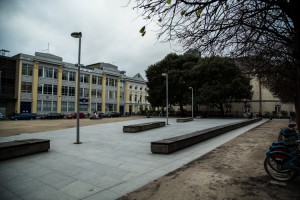
Ciarán Flynn was the resident at the March meeting. He showed up uninvited, he said.
There was a campaign by residents to restore grass to the park in 2006, but this came to nothing.
It was this meeting in March which reignited the campaign, when Flynn became concerned that the park might be targeted for commercial use. He even mentioned worries over suggestions of a café.
Social Democrat councillor for the area Gary Gannon said that no residents had been in touch with him over any concerns about the park.
He would like to see more greenery in the space, but isn’t opposed to the idea of the Tram Café. As he sees it, it would be an extra amenity for people.
“The fact that it’s going to be a tram, means it will show a bit of our history and help to pass on our heritage,” he said.
Last Friday, councillors for the area met with the parks superintendent, Les Moore. They were told that final proposals to improve the park are being drawn up and will include more tree and grass planting.
“I am pleased to hear this,” said Cuffe, of the Green Party.
However, the park is unlikely to be completely covered in grass, said Sinn Féin councillor Janice Boylan. “People have gotten used to cutting through there.”
Plans are still in the early stages, said Boylan. But there were suggestions that the gravestones be buried and a plaque put in place to remember the dead, instead.
She is in favour of the Tram Café as well.
“The way I look at it is, it will bring a bit of footfall to the area. It will encourage people to come into and use the park,” she said.
The draft proposals are due to be presented to the central area committee early next year.
Ciaran Flynn – 14 September 2015 - www.villagemagazine.ie
Tone Deaf

After years of Dublin City Council (DCC) vandalism and neglect, its senior management has conceded that the current layout of Wolfe Tone Park which it manages – and indeed designs – has not worked, and redevelopment is being considered.
But are DCC capable of appropriately redeveloping the park; and, can they be trusted to?
Wolfe Tone Park is located on the site of the old St Mary’s Churchyard: the cemetery attached to the church on Mary Street, opposite the Jervis St Shoping Centre. For almost three centuries the park served the community and its visitors as a place to respect the dead and, later, a place to embrace the living.
Local residents share fond memories of the park as their childhood playground and communal garden, while photographs reveal the park as a popular sanctuary for respite in a busy city-centre.
However, with the arrival of the Jervis Centre and a desire to extend the success of Henry St as far as Capel St, the City Council considered there was an imperative to cater for commerce, and the tired shopper – more than beleaguered inner city residents whose voice rarely registers with usually suburban decision-makers. In this case residents too were content with changes in the belief that the walls and railings conduced to “anti-social behaviour” and made it difficult to police the park. In the event, there has been no diminution of obnoxious gatherings in the park. The space and indeed the area are so hostile to children and families that it is inevitable there will be drinking and the public carousing that characterises much activity in many of Ireland’s urban parks.
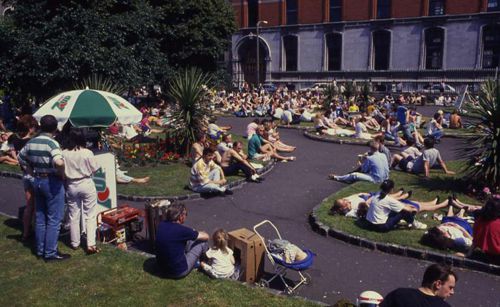
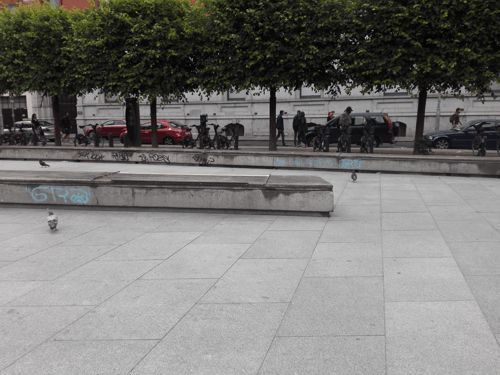
The slate was clean for DCC to redevelop the park into a faux European-style plaza. In 2001 the park garden and railings were removed, and the headstones, which had been uprooted years before, re-arranged to accommodate a bland, windswept plaza furnished with a bleak array of concrete plinths that serve as seating. The new and voguish plaza was described as an “urban beach” by Boyd Cody Architects which won the architectural competition to overhaul the park for DCC, but the grass that was its centrepiece has long-since been removed by the DCC, without any attempt to obtain planning permission or to assess the environmental impact. St Mary’s Church, the oldest parish church in Dublin and one of its most important buildings has been converted to pub use, with drinkers swilling over memorial headstones in a Wren-quality building that deserves more dignity.
Since 2001, the park has been commercialised and sterilised by DCC. Like waves eroding a cliff-face, under-attended gaudy events and commercial promotions consume what remains of the park. One TV3 production, ‘The Box’, did enough damage to warrant the closure of the park to the public for three months as the last solitary wedge of grass was removed to make way for the brown desert-like deposit that can be seen there today.
However, applying the cautionary theory of the broken window – where tolerance of a single act of vandalism encourages others to vandalise – DCC cast the first stone.
DCC continues to renege on a 2006 commitment to restore the park while facilitating and effecting damage to, and disparagement of, the relics of the original setting. Many of the headstones around the park have been defaced, and some broken by DCC’s own vehicles; other vehicles are permitted to join in the destruction while conducting typically tasteless events. Reports of infringement to DCC are met with apathy; we do not know of a single resident complaint or concern that has been heeded by the council in relation to Wolfe Tone Park.
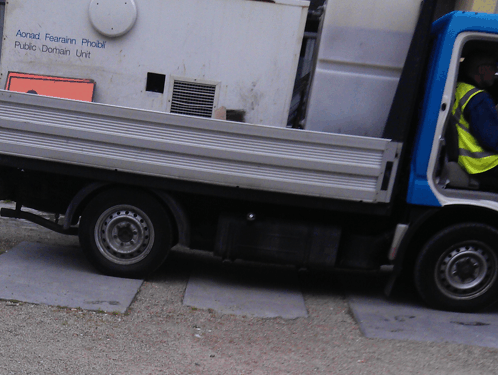
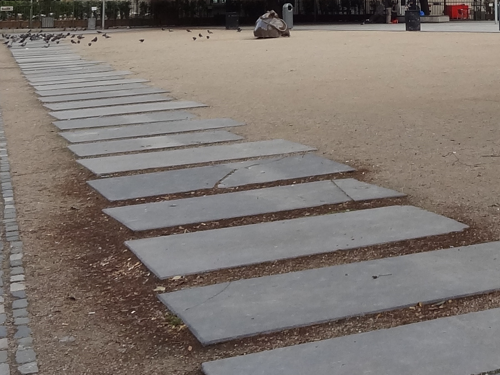
For years the park has been used to house what is believed to be, a DCC staff toilet within a vandalised metal container. DCC staff occupy the parking bays on the west side of the park; identifiable by the branded vests draped over the steering wheels.
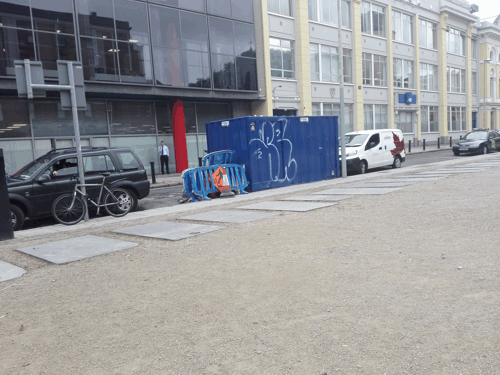
A ‘Dublin City Centre BID [Business Improvement District] Company Ltd’ (BID) information kiosk was wheeled into the park, presumably from Henry Street, and has been abandoned for the past few months. The DCC litter helpline failed to have the obstruction removed; suggesting either a lack of willingness or control.
Suppliers of goods and services to the Church Bar regularly park their vehicles on the north end, while ordinary residents and visitors anxiously await the next time we are a few minutes late returning to our clamped cars on Jervis Street – that is, if indeed, we can find a vacant space to begin with.
Today the park is closed to the public, hidden behind black hoardings and beneath the stage of Dublin Fringe Festival Ltd’s Spiegeltent; another antisocial event that will broadcast amplified music into the homes of residents living only fifteen meters away for the next three weeks. It is clear that the park, which should be an amenity for hard-pressed residents in one of the least green parts of the city, is an inappropriate venue for events such as funfairs and ice rinks, but despite appeals and objections from local residents DCC have granted permission for the Tiger Beer Dublin Fringe Festival circus. Of concern too is that, after months of objections and requests for information, residents were directly informed that permission for the event had been granted only hours before the circus rolled into the park. This would suggest that the event was advertised long before permission was granted, or that DCC waited until the eleventh hour to notify the residents that permission had been granted for the amplified music event that will run until at least 11pm/12am for three weeks in September.
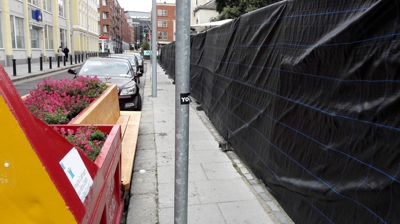
Perhaps deluded by group-think, encouraged by internal back-slapping, or empowered by commercial belly-scratching DCC staff appear oblivious of their own contribution to the demise of the park.
At a DCC/BID meeting in March, BID members proposed that the park be rebranded as “Wolfe Tone Square” in a cynical attempt to lower public expectations of ‘the space’. Discussions also took place about the commercial value of ‘the square’ and the idea of extending the park into a neighbouring business that would accept a rent from the council. This fee would, of course, be offset by other commercial ventures proposed for the park. But why would DCC consider another circus tent, Spiegeltent, carnival, Ferris wheel, ad-space, or coffee kiosk over a simple garden park contained within traditional railings in an area deprived of green space?
While some may suspect that DCCs’ failure to provide a public green space is a carefully engineered softening-up exercise to push through BIDs commercial proposal, it might very well be the case that DCC are just not up to the task of developing or maintaining Wolfe Tone Park.
In any case, Dublin City BID Company Ltd (BID) should not be leading a proposed redevelopment of a public space; and DCC should surrender the public asset, that they have destroyed, to the Office of Public Works (OPW). The handover should be simple: the OPW can easily be found in Dublin, maintaining St Stephen’s Green and The Phoenix Park.
In safer hands the park walls and railings, still stored in DCC’s Marrowbone Lane depot, should be reinstated, and apologies offered all around. The message on Wolfe Tone Park and other parks for DCC from those who actually live in the inner city is simple: just green them. •
Louisa McGrath – 09 September 2015 - dublininquirer.com
A Community Group Struggles To Revive Wolfe Tone Park
Everyone agrees that Wolfe Tone Park needs a bit of TLC. Home to the council’s portable staff toilets, its hard, dull appearance does little to entice people in. And neither do the loiterers drinking cans at midday or people diving behind the historic tombstones on search-and-rescue missions for stashed drugs. The local residents have been campaigning since 2006 to get some greenery returned to the park. Now, because of worries about its future, they’ve revived their effort and formed the Jervis/Wolfe Tone Park Community group. Their goal: to see the park restored to its previous grass-filled, fully-fenced design of the 1990s.
Ups and Downs
Named after the adjacent Wolfe Tone Street, where the revolutionary was born in 1763, the park was originally a graveyard for St Mary’s Church. It was a final resting place for historic Irish figures like United Irishman Archibald Hamilton Rowan and Mercer’s Hospital founder Mary Mercer.
The land was deconsecrated and handed over to Dublin City Council in 1966, and the gravestones were moved against the wall, so the space could accommodate a public park. In 1998, a new design brought concrete to the space and gravestones were used as flagstones; there was no longer any need for a caretaker.
On a grey day, this grey park doesn’t resemble a graveyard in any way. But it is certainly no place for the living.
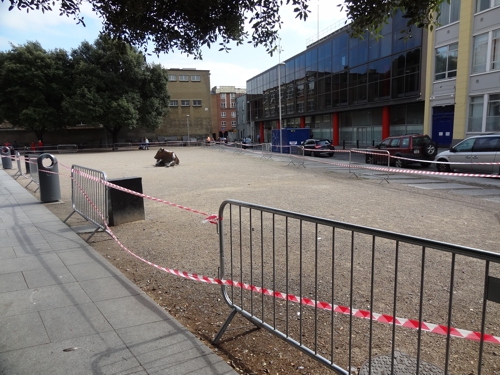
Standing under the trees for cover from the lashing rain, Ciarán Flynn, who’s lived facing the park for more than 15 years, explains its problems.
There’s the anti-social behaviour. There are the commercial vehicles that park there – without authorisation, according to the council. And there are the vehicles that drive across, which have cracked some of the 300-year-old gravestones.
Dublin City Council accepts that the current design of this “park/civic space” has not been fully successful, has not worked out as well as its designers had hoped.
“It is always a challenge to properly manage and maintain a space like this in an urban setting, where there inevitably are incidences of low-level anti-social behaviour,” said a spokesman for the council.
Despite the park’s problems, Flynn says it still attracts tourists. And, indeed, although the weather is miserable, during the hour that we stand there, we see walking tours and small groups of sightseers coming through.
Going Backwards
Local residents want to see the park restored to its “former glory”.
Though it is generally accepted that having a park without railings reduces anti-social behaviour, Flynn says here that has not been the case – the problems have definitely worsened.
He hopes gates would stop drunk people having parties in the park at three o’clock in the morning, after the pubs close.
“At the moment, you can see it’s a hostile environment . . . You’d be brave to hang out there,” says Flynn.
The group has been lobbying councillors and has received the support of councillors Mannix Flynn and Ciarán Cuffe, as well as the Dublin Civic Trust.
Call to Action
The residents’ campaign originally began nine years ago with Ciarán Flynn and the late independent TD Tony Gregory leading the way.
The park had already been redesigned to blend in more with the rest of the concrete city, and then the last of the grass was removed by the council and replaced with “moon dust” (gravel).
That’s when locals began to take issue with the situation, says Flynn.
The grass was removed after The Box – a TV3 televised event – damaged it. The council promised to return the park to normal, but the grass wasn’t restored.
That first incarnation of the campaign eventually fizzled out. Then, in March of this year, Dublin City Council held a meeting to discuss the future of Wolfe Tone Park – and that reignited locals’ interest.
Flynn says residents weren’t informed of the meeting, and he found out late the night before it was due to be held. Representatives from the council, DublinTown – the Business Improvement District – and the local Garda station were there.
Widespread Support for Change
“The first order of business at the table I was sitting at – table number one – was the commercial value of the footprint of the space,” says Flynn, with disbelief. “There was speculation about what it was actually worth.”
Well-formed plans to extend the plaza into the bottom of the AXA building where there would be commercial premises were also suggested, he says.
DublinTown CEO Richard Guiney attended the meeting, which he describes as a workshop for the council to come back with plans for the park, and explains that it was just an opportunity to share ideas and that nothing should be assumed.
Guiney says he’d like to see the park become more popular. “Basically, it’s fairly well accepted that it’s not working as it should, it’s not as attractive as it should be . . . We’d like to see it being better used. That’s our thinking on it,” he explains.
He envisages a space where people can relax and stop off for lunch. What does he think of restoring it to its former green and leafy glory? He thinks having a green space in the city is quite an attractive idea.
Representatives of AXA were at the meeting too and, according to spokeswoman Andrea Cassells, “support the We are Dublin Town Group on their view for the Wolfe Tone Park”.
A neighbour of the park, Tom O’Rahilly, director of the Leprechaun Museum, believes the park needs to be made as active as possible, but that it should also be respected as a burial site.
In April, Mannix Flynn put forward a motion to restore the park, and the council passed it.
Dublin City Council is still in the early stages of developing a design plan, which “will likely involve restoration of grass to most of the park”, but it hopes to have draft plan ready before the year is out, according to the council’s press office.
Restoring the railings will also be considered and relevant stakeholders – including local residents – will be consulted extensively before a decision is made, says the council press office.
Fringe Furore
The park is often used for events like markets and musical events. The council has said that events organisers are asked to consult with local residents and businesses before an event takes place. As part of this week’s Tiger Dublin Fringe Festival, Spiegeltent is coming to the park. It features a brass band. The residents – who are behind protected single-glazed windows just metres away – became concerned. Dublin City Council issued them an invite to discuss the event, but when residents attended the meeting no representatives of the council were present, only people from DublinTown and the Fringe Festival. Councillor
Mannix Flynn, who was there, says he was shocked. “It’s not good enough,” he says. “It’s all too often you see this indifference.” After they eventually met with council officials, the community group opposed the event. But they were informed the day before it was set up, that the council had granted it permission to go ahead. A Dublin City Council spokesperson says the council spoke with residents about the event, and that further consultation would have been arranged if it had been requested.
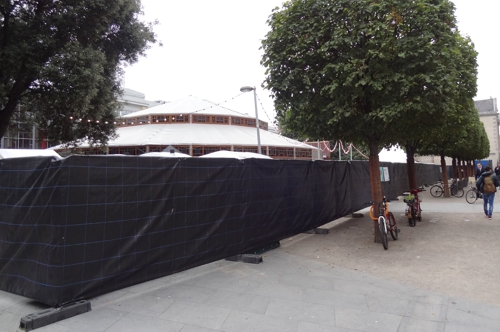
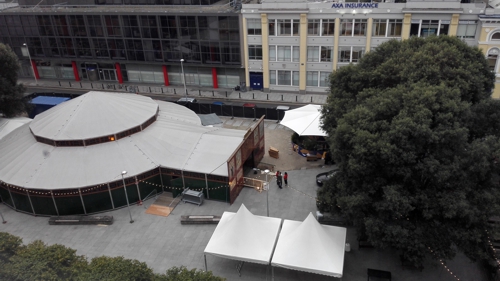
Photos added by wolfetonepark.com
Taking Back the Park
Ciarán Flynn says he’d like to see the Office of Public Works take over the site, because Dublin City Council has failed. Flynn says he is genuinely worried about the future of the space – which, as it is, can be closed off to locals without a ticket. He’d like to see it given back to the people of Dublin, he says. “We’d also like to put forward the idea that locals would actually work in maintaining and stewarding the area . . . I can’t see why that wouldn’t help curtailing some of the anti-social behaviour,” says Flynn.
Councillor Mannix Flynn says some organisations would like to see the park turned into a commercial concern. But he doesn’t want to see that happen. People should be afforded a bit of down time, when they aren’t being targeted commercially, says the councillor. He thinks the space should be a place for “workers, children and shoppers to get away from the hustle and bustle”. “You can’t give in to anti-social behaviour by making the place hostile to everyone,” he says.
Sharon McGowan – 23 March 2015 - herald.ie
Turn 'hostile' Wolfe Tone plaza into a park again, says councillor Mannix Flynn.
THE former park at Wolfe Tone Square should be restored as a green space featuring its ancient grave stones, a city councillor has argued. The park, which had become known for anti-social behaviour was converted into a modern plaza in 1998 to mark the 200th anniversary of the death of Irish revolutionary Theobald Wolfe Tone, who was born nearby.
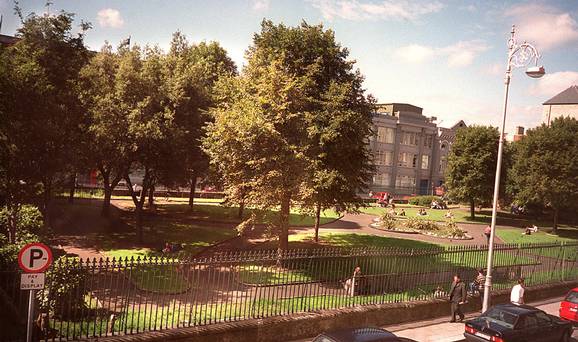
Now Cllr Mannix Flynn wants to see the green area restored, criticising the lack of parks on the city's northside and describing the current set-up at the square as "hostile". "It was a place that a of people would come to visit with the beautiful church and park," he told the Herald. "A while back there was a bit of anti-social behaviour in the park and because of that it was more or less demolished by the City Council and all traces of its origin have been wiped off."
Cllr Flynn said that there is "nothing inviting" about the area since the park was built over. "The grounds of the old park are now just hostile," he said. Many of the headstones from the original graveyard beside St Mary's Church have been moved in what Cllr Flynn branded an act of "sacrilege". sacrilege "In my opinion they've basically committed an act of sacrilege by turning the old headstones into flagstones," he said. "This part of the city is ideal for regeneration and there's a real lack of green space in the O'Connell Street area - there isn't even a place to sit down."
The councillor suggested that more of an effort should be made to turn the park into a commemoration for the national historical figure, and that the current plaza should be redesigned into a green space similar to the original park. "This place would enshrine the legacy of Wolfe Tone in this decade of celebrations and commemorations," he said in a motion to Dublin City Council. "A living, thriving space in the form of a green park with a connection to the origins of the original park green space and graveyard would be ideal," he said.
Mark Hilliard – 13 June 2015 - IrishTimes.ie
Dublin anti-Bid drive claims 500 signatures against ‘double tax’ Petition attracts backing from local business.
Hundreds of businesses have signed a petition protesting the “double taxation” imposed by mandatory payments to the Dublin Business Improvement District (Bid) and seeking a means to leave the organisation. The signatories, including well known names such as Stock, the Central Hotel, Rhinestone Jewellers and Lillie’s Bordello have expressed frustration at having to pay a levy for the Bid which “overlaps” with local authority rates. Organisers say support has now grown to more than 500 businesses. The Bid, which is branded “We Are Dublin Town”, was established in 2007 and renewed with majority backing in 2012, giving it a mandate to improve footfall in the city centre through marketing and promotional initiatives, a function it says it performs to a high standard.

However, those who believe it is just another financial burden for small to medium-sized businesses hope that, by reaching a target of 1,000 signatures, it can convince Dublin City Council to change the system, namely the controversial mandatory contributions enshrined in legislation. “We are being double taxed. I don’t want to be part of the Bid now. They are doing absolutely nothing for businesses on George’s Street,” said retailer Jack Irwin of Down to Earth, typifying many of the concerns. Myles Tuthill, manager of Dublin’s Central Hotel, said he is faced with an additional €5,400 bill on top of annual rates of €99,000. “They don’t bring anyone into my hotel. Not one person in the years I have been there came in and said Bid sent me.”
Support
The organisation covers 2,648 premises in the capital’s central business district incorporating large parts of Dublin 1 and Dublin 2 postcodes. Grounded in legislation, and modelled on other jurisdictions, particularly the UK, companies pay a levy to the company through Dublin City Council as a percentage of, and in addition to, their rates.
Controversy surrounding the system is not new. Last year, many businesses in Dún Laoghaire were vexed at having to participate, with just a 55 per cent vote in support.
In Dublin, the petition has attracted backing from a number of hotels, travel agents and numerous retail outlets. One of its proponents, Kate O’Neil of the Silver Trout on South King Street, said payment should be voluntary. “I have seen no improvement or uplift in trading conditions nor any cost benefit to my business since the inception of Bid in 2007,” she said.
Bid chief executive Richard Guiney roundly defended its work and said it had twice received the democratic backing of its members, without which it could not function. “Businesses who pay us, if they felt that we were just duplicating what Dublin City Council did, well they would just say no,” he said. That position is borne out in the voting. In 2012, 1,063 backed the continuation of the Bid with 511 against (68 per cent of a 45 per cent turnout). Ratepayers vote every five years and Mr Guiney is confident of an increase in support in 2017. He cites several initiatives, including promotional campaigns like the Dublin Fashion Show and Dublin at Christmas; a close working relationship with gardaí to tackle anti-social behaviour, graffiti and street cleaning; reduced waste and insurance costs and the provision of Christmas lights (20 per cent of its approximate €3 million annual spend).
FootfallThere are regular district meetings for members, and an AGM of members is to be held on June 23rd. “Fundamentally we are very transparent. Everything is up on our website, we operate to a very high level of corporate governance; we are very efficient,” Mr Guiney said. “We have to concentrate on why we were set up and that’s about getting footfall back in the city, it’s about increasing the market share for businesses in the city, it’s about being relevant for businesses.”
Ciaran Cuffe – 11 September 2014 - www.villagemagazine.ie
Park Life
It’s Sunday morning in the Phoenix Park. A group of Brazilians are playing football under the shadow of the Wellington Monument. In the distance a herd of deer look on. One suspects the Duke of Ormond would be happy to know that 350 years after he purchased the lands for a royal deer-park, deer and residents happily share the space.
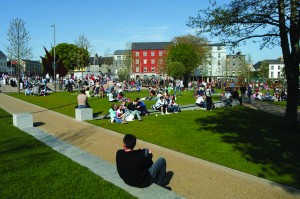
Yet all is not well with the state of our parks. As cities increase in population development pressures threaten the future of green space. A new generation of city residents living in small apartments expect more from their parks, and cash-strapped local authorities find it difficult to meet changing expectations on shrinking budgets. The Phoenix Park itself is riven by roadways and has been described as “remorseless prairie, pitches and link-roads” with little of the sequestered charm of New York’s Central Park or London’s great parks.
The Croppies Acre Park in front of Collins Barracks is currently closed to the public and was recently transferred from the Office of Public Works to Dublin City Council. The ambitious plans for a park at the Royal Canal beside the National Conference Centre in Dublin’s Docklands have not been realised. The Liffey Quays which could be a linear park from Heuston Station to Dublin Bay are choked with cars, with footpaths barely wide enough in parts for a single pedestrian. Uproar in certain quarters greeted proposals for traffic calming there. The park at Ormond Square in the north inner city has a sign banning football a few metres away from the plaque marking the birthplace of footballer Johnny Giles.
Green spaces are often converted to ‘hard’ spaces as local authorities find them easier to maintain. Eyre Square and Wolfe Tone park are unfortunate manifestations of the tendancy.
However, there have been notable achievements in recent years. Ringsend Nature Park is a wonderful linear park between the city and the sea on the site of a former landfill site. St Catherine’s Park in Lucan combines old woodlands and playing pitches beside the banks of the River Liffey, and it must also be one of the few Irish parks with its own Twitter account.
In Dublin’s North Inner City the City Council finally landscaped a derelict site on North King Street that had been in their ownership for a quarter of a century. It now has been grassed and planted with shrubs and trees and is a model for ‘temporary use’ parks that make use of lands that face an uncertain future. A similar approach was taken with Granby Park, a ‘pop-up’ park on Dominick Street last summer, though critics worry about the long-term legacy of temporary interventions. Nearby St Michan’s park on Green Street on the site of the site of an old jail provides a meeting place for Irish and immigrant families with a range of play facilities. The City Council has committed to reinstate the grassland integrity of Mountjoy Square.
At a time when funding is scarce much can be achieved with some creative thinking. Glasnevin Cemetery and the Botanic Gardens share a common boundary and recently opened up a gate allowing visitors to walk between the two, adding civic value at a low cost. A pedestrian crossing linking the National Gallery and Merrion Square could greatly increase access to one of the great Georgian Squares. Nearby, however, Fitzwilliam Square remains under lock and key, sharing the dubious privilege along with De Vesci Gardens in Dún Laoghaire of being private squares in neighbourhoods lacking in publicly accessible green space.
Little headway seems to have been made in addressing the ubiquitous challenges and opportunities of our post-war soulless suburban stretches of grass. Perhaps local councils, the Office of Public Works and indeed, crucially, Nama are not protecting and enhancing public spaces with the zeal and imagination necessary if they are to become engines for a transformation in our quality of life.
The role of parks and open space in fostering biodiversity is now recognised. The “Green City Guidelines” published in 2008 by the UCD Urban Institute, Dún Laoghaire Rathdown and Fingal County Councils showed how nature and green networks can be enhanced in cities and towns, even next to high-density urban developments. They also illustrated the importance of green roofs, green walls, permeable surfaces and sustainable drainage systems in protecting and enhancing the environment.
More importantly they emphasised the importance of access to nature in an urbanising world. Guardian writer George Monbiot has written of the crucial role “re-wilding” of open spaces can play, not just in fostering biodiversity but in opening up human nature and imagination.
A debate is needed on the risks of promoting wild spaces where children are exposed to the real-life risks of climbing trees and encountering strangers and of the dangers in lost spontaneity, and lost exercise in a world of burgeoning obesity of cosseting our children in carefully manicured spaces and gated playgrounds with shock-absorbing surfaces. Over the coming months in a series of articles Village will take a look at green and public spaces across the country and ask what needs to change to ensure that they are suitable for today’s needs. We will highlight the best and worst examples of the planning of open space and parks from recent years.
Treatment of St Mary's Churchyard, Dublin (Wolfe Tone Park)
Sean Murphy – 04 April 2006Architectural conservation, as one should never tire of pointing out, is about preserving as much as possible of the old, consistent with the need to create new buildings and spaces. Of course, nearly everyone agrees that there should be some preservation of our built heritage, the problem lies in defining just how much is to be kept. Dublin City is very much a case in point, being subject to a frenetic pace of new building courtesy of the 'Celtic Tiger' economy these past number of years. Inevitably, some fine old buildings have been viewed as surplus to requirements by the impatient cubs of the said Tiger, and have been reduced to rubble as a result.
There are exceptions to this trend, it must be said, where some attempt is made to preserve an old building and put it to new use. One example is that of St Mary's Church in Dublin, which having been closed for many years due to the decline of its Church of Ireland congregation, was in a seriously deteriorating condition. St Mary's has now been refurbished for use as a pub and restaurant, and while hardly ideal and somewhat flash, this use is preferable to the alternative of continued decay. However, it is not the church building which primarily concerns us here, but the adjoining churchyard and its gravestones, which have recently been subject to radical overhaul by Dublin City Council (characteristically, this is a modern replacement of the centuries old name 'Dublin Corporation').
St Mary's Churchyard, now called Wolfe Tone Park, was the burial place of a number of famous individuals, including the United Irishman Archibald Hamilton Rowan, the founder of Mercer's Hospital Mary Mercer, the philosopher Francis Hutcheson and the hanging judge Lord Norbury (though apparently not the actor and theatre manager Thomas Sheridan, as is indicated on a wall plaque erected by the City Parks Department). In keeping with the modern mania for windswept open urban spaces, the old churchyard railings have been eradicated, and a desert-like dust covers some of the pathways.
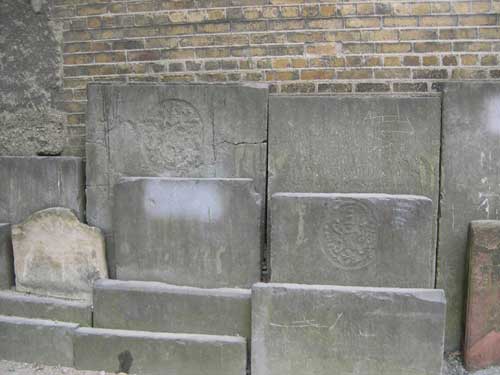
The above photograph of stacked gravestones in a corner of St Mary's Churchyard illustrates a past method of dealing with old memorials of the dead in Dublin burial places, the result being that the stones are preserved but most of the inscriptions simply cannot be read. The city fathers obviously considered that a different approach was required today, but alas what they have chosen to do is much worse. Numbers of the old gravestones in St Mary's have been laid out flat in the manner of paving stones, so that visitors may walk freely over them. Leaving aside the matter of disrespect to the dead, it can be considered how this will accelerate the already established process of wearing away of inscriptions. Historians, and genealogists in particular, value the information to be found in these archives in stone, and it is difficult to believe that any experts in these disciplines would have given their approval to the way in which gravestones have been treated in St Mary's (characteristically, they probably were not consulted).
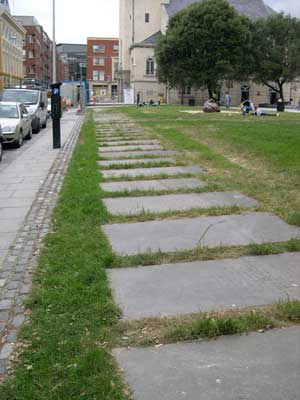
Sean Murphy
Centre for Irish Genealogical and Historical Studies
4 April 2006
Public Opinion
All comments from Dublin City Council website.I agree with the comments regarding the changing of this bit of parkland greenery in the middle of the city , and regrettably being changed into a civic continental style piazza. What a shame !! Great memories of a childhood in more innocent times.
I was born on Capel Street in 1963 and played in this little park every day... We also played football on Wolf Tone Street and adjoining streets, we played handball in the handball alley on Green Street .... Wonderful and happy innocent days in north inner city Dublin.
EEEEEK! It's an Incredibly bland looking space now, how was it allowed. Vanishing Dublin indeed. So great to see all these old photographs though.
I used to love hanging out their [sic] its gone now what were they thinking.., paved over the graves.
Wolfe Tone Park Community
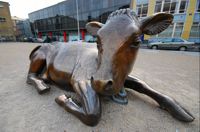
The Wolfe Tone Park Community is a non-commercial community-based initiative established to protect Wolfe Tone Park.
Agenda:Full Restoration of Wolfe Tone Park as a non-commercial green space (c.2017)
Protect the park from commercial targeting (2016)
Protect the park from DCC/BID 'Tram Cafe' proposal (on-going)
Monitor any proposals or plans for the park (on-going)
Protect the park from 2017 DCC/BID 'Frankenstein' renovation (on-going)
Inclusion of Park Restoration in Dublin City Draft Development Plan 2016-2022 (16-Sept-15)
Prevent commercial vehicles from parking in the public space (21-Dec-15)
Secure the Park Status of Wolfe Tone Park (not Square) (21-Dec-15)
Prevent amplified music festivals taking place in the park (01-Nov-15)
Removal of DCC 'mobile' staff toilets from west side of the park (15-Oct-15)
Removal of BID/DublinTown kiosks from within the park (01-Oct-15)
Removal of commercial furniture from within the park (10-Nov-15)
Prevent Dublin City Council vehicles from vandalising old tombstones around the park (16-Sept-15)
Establish direct contact with DCC management regarding park condition & neglect (01-July-15)
